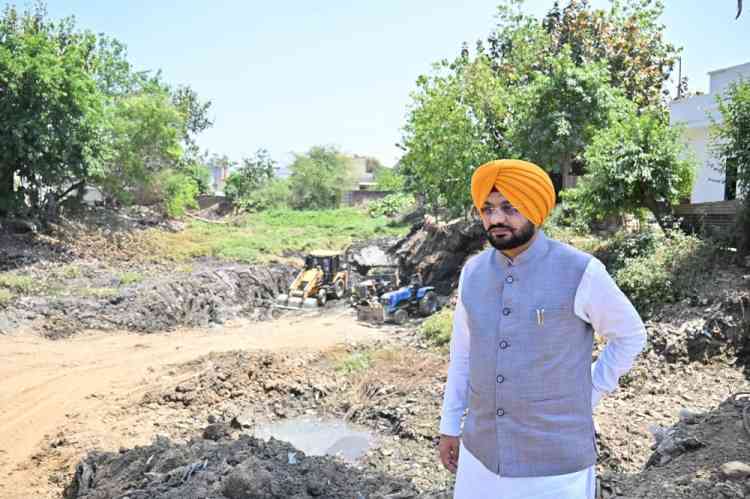Erratic rainfall pattern due to Climate Change caused flooding in Punjab last year: PAU Study
Punjab Agricultural University’s report on the Punjab Floods 2023, released recently has brought out that flooding in Punjab last year was due to peculiar rainfall patterns in Punjab and Himachal Pradesh.

Ludhiana, August 21, 2024: Punjab Agricultural University’s report on the Punjab Floods 2023, released recently has brought out that flooding in Punjab last year was due to peculiar rainfall patterns in Punjab and Himachal Pradesh.
The unprecedented flooding of 2023 in Punjab resulted in colossal damage to life, livestock and agricultural produce. It thus had a devastating impact on the populace, as a quarter of the working population in Punjab, which is also known as India’s Bread Basket, is dependent upon agriculture and allied sectors for their livelihood. Climate vulnerability is also expected to inflict further harm to the community, since it is projected that by 2050, maize yields in Punjab would be decreased by 13%, cotton yields by 11%, and rice yields by roughly 1%.
Climate change is one of the world's most pressing issues today, due to changes in climatic factors such as temperature and rainfall patterns. According to the World Meteorological Organisation (WMO), the average temperature of the decade 2014 - 2023 has been ~ 1.20°C above the pre-industrial (1850 - 1900) average globally. The impact can also be seen locally, as the northern state of Punjab has been witnessing declining rainfall since the year 2000, along with having witnessed two tornadoes and a major flooding since March 2023.
A study was recently conducted by Dr Prabhjyot Kaur, Dr Sandeep Sandhu and Dr Simerjeet Kaur of Punjab Agricultural University, Ludhiana to understand the causes and impact of floods of 2023 in Punjab. Their learnings from the study have been elucidated by Parinita Singh from Clean Air Punjab. The flooding in Punjab happened as a consequence of peculiar rainfall patterns in Punjab and Himachal Pradesh in July of the same year. While Punjab received about 5 per cent less rainfall than typical during the 2023 monsoon season, July was an outlier, with the rainfall exceeding the normal by 43 per cent. A similar pattern was spotted in Himachal Pradesh, which witnessed 75 per cent more rainfall than normal in July. The rainfall in Himachal Pradesh, however, peaked at its highest point between July 7th and July 11th, when it exceeded 436 per cent of normal within four days.
The rainfall received in the upstream state of Himachal Pradesh is the source of water for Punjab's three major rivers, Ravi, Beas, and Sutlej, as well as their tributaries. The four-day period of excessive rainfall in Himachal Pradesh caused the rivers in Punjab to breach, resulting in floods in various parts of Punjab. In the same period, heavy rainfall continued across other parts of Punjab and Himachal Pradesh which significantly increased the water level in the reservoirs, making it imperative to keep the floodgates at Bhakra and Pong dams open, which further worsened the condition. This resulted in an inundation of fields, homes, and villages, particularly in the Bet area, forcing the residents to evacuate their homes and abandon their fields. The districts of Patiala, Mohali, Tarn Taran, Gurdaspur, and Fatehgarh Sahib felt the most brunt due to the overflowing Ghaggar, Beas, Sutlej, and Ravi rivers.
Consequently, 2.21 lakh hectares of cropped area or 7 per cent of the paddy crop was destroyed. Additionally, other crops of vegetables, maize, sugarcane and cotton were also damaged because of water stagnation as adequate drainage facilities could not be provided in time. Furthermore, the floods led to the displacement of several animals further adding to the losses for farmers. The saved livestock could not be sufficiently productive either because of the deterioration of the fodder quality due to the inundation of the fodder fields. The urban areas also bore the consequences of the floods as the infrastructure was significantly impacted because of the collapse of numerous roads and bridges, residential properties and the electricity infrastructure.
Author of the study Dr. Prabhjyot Kaur, Principal Scientist in Agrometeorology at Punjab Agricultural University, Ludhiana said, “Climatic extreme are becoming frequent and resilience as well as adaptive measures are the need of the hour. The novel concept of Community Nursery and Langar of rice nursery advocated by PAU and strengthened by administration and farmers is prime model to be replicated in parts of the country where floods are frequent.”
Dr S S Sandhu, Principal Agronomist, PAU, stated, “Proactive approach along with Proper guidance by PAU and adaptive behaviour of farmers presented an example of adoptable and reproducible climate resilience, which can be adopted in other regions of India.”
Dr Simerjeet Kaur, Principal Agronomist, PAU, stated, “Climate Change destroyed 2 lakh hectares of land in Punjab, shedding light on this global challenge. But with the efforts and collective action of farmers, combined with the expertise of subject experts, and langar (free distribution) of paddy crop, Punjab has been saved from the catastrophe laid by floods.”
Parinita Singh, State Coordinator of Clean Air Punjab, stated, "As Punjab, the breadbasket of India, confronts the effects of climate change, it is imperative to focus on climate-resilient agriculture. Our state’s agricultural productivity is critical for national food security, and adopting diverse, climate-resilient practices is essential. Embracing a range of sustainable farming techniques not only enhances our ability to adapt to climate variability but also supports biodiversity, protects our natural resources, and secures the livelihoods of our farmers. This approach will help ensure both environmental and economic sustainability for Punjab’s future."


 City Air News
City Air News 









